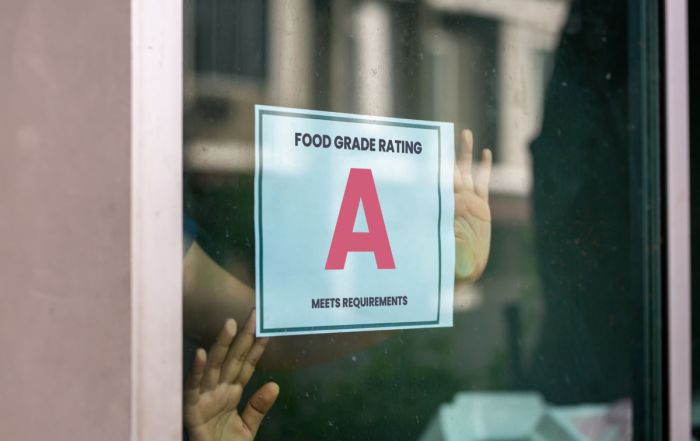Keeping Food Safe While Serving Outdoors
This afternoon I met some friends for lunch and as I drove through our beautiful downtown area in Manhattan, KS, I noticed that many people were taking advantage of the gorgeous weather and dining outside with friends. For our local community – outdoor dining is one of the remnants of COVID that we actually have come to enjoy on beautiful days. With spring in full swing and summer just around the corner, many foodservice operations are taking advantage of the warm weather by offering outdoor dining options.
Outdoor dining can be a great way to attract customers and increase revenue. Of course, we see this in restaurants, but we also see it in schools through the summer meal program. While the venues and style of service are a bit different, food safety must remain core to these activities. Here are some tips for keeping food safe while serving outdoors.
- Keep food at the right temperature.
- When serving food outdoors, it is important to keep hot foods hot and cold foods cold to prevent the growth of bacteria. If catering off-site events and/or serving outdoor buffets, it is vital to use chafing dishes, warming trays, insulated coolers, and ice baths to keep hot food at or above 135°F or cold food at or below 41°F. Monitor food temperatures regularly with a calibrated food thermometer to ensure that they stay within the safe temperature range.
Outdoor dining can be a great way to attract customers and increase revenue…but, food safety must remain core to these activities.
- Protect food from pests.
- Pests such as flies, bees, and ants can be a major problem when serving food outside. Make use of food covers, mesh netting, or other barriers to protect food from airborne insects. Keep food covered when not in use and store it in sealed containers to prevent pests from accessing it.
- Practice good hygiene
- I’ve often found that when our employees get outside the walls of our foodservice operation, they sometimes forget the basics of proper hand hygiene and sanitation. It is vital to remember the basics of hand hygiene – especially when you may not have handwashing stations as easily accessible as you do in your normal business. Proper hand hygiene is critical to preventing the spread of foodborne illnesses. Make sure that staff members wash their hands frequently and thoroughly. Provide hand sanitizer stations for customers and staff members to use and encourage them to use them often.
- Control food waste
- Ten years ago, I would have likely argued that food waste was not a food safety issue. But it can be in this case because food waste can attract pests and if not stored appropriately can be a breeding ground for pathogenic bacteria on those warm and sunny days. When serving food outdoors, use smaller serving portions and limit the amount of time that food is left out. Store excess food in sealed containers and dispose of it promptly.
- Plan for inclement weather
- Inclement weather, especially in the Midwest where I live, can pose a challenge when serving food outdoors. Plan ahead by having a backup plan in case of rain or other weather-related events. Use tents or other shelters to protect food and customers from the elements and have a plan for quickly moving food and equipment indoors if necessary.
Last, but certainly not least – have a plan in general! Don’t just decide mid-morning to serve lunch outdoors. As the old saying goes, failing to plan is planning to fail (or something like that). Serving food outdoors can be a great way to attract customers and increase revenue, but it also requires special attention to food safety. Risk Nothing.
READ MORE POSTS
Embracing Technology for Enhanced Food Safety in Foodservice Operations
Technology. We love it, we hate it. I’ve always been fascinated by technology; I remember getting my first Blackberry in the mid-90s and thinking it was the pinnacle of technological advances. Before that, I remember ordering a dictation program in college that was going to revolutionize the way I “typed” my assignments. Looking back, it really wasn’t worth the box that the program came in. Now, we have ChatGPT that will write the entire paper for us!
Meat Color and Doneness: Persistent Pinking
Late in June, my family and I were able to visit the Black Hills, an area of the country in which I have not had the opportunity to spend much time. One evening, as we dined at a local restaurant, I observed a table across the dining room sending back a dinner. While I couldn’t hear the entire conversation and I certainly wasn’t trying to eavesdrop, it was apparent that the customer was unhappy with the cooking of their hamburger and was sending it back because it was too pink in the middle. That immediately brought to my mind the phenomenon known as persistent pinking. A term I became familiar with because of work done by some colleagues here at Kansas State, which they present each summer to a group of foodservice operators who join us on-campus for an in-depth week-long look at all things food safety.
Quat Binding – Why this Can Have a Disastrous Impact on Your Sanitation Program.
In June, I had the opportunity to represent FoodHandler and speak on food safety behavior for customers of Martin Bros. Distributing in Waterloo, Iowa. One of the questions that was asked caught me a little off guard. The question was about quat binding. It caught me off guard not because it was a bad question, but only because it was not something I had previously been asked nor had not yet been exposed to the phenomenon. However, I soon learned that in certain jurisdictions, it is resulting in changes to how sanitizing cloths are to be stored in sanitizing buckets (or not) in the foodservice industry. When I returned home from the trip, I had to dig into it to learn about what quat binding is and how it might impact foodservice operations.
Are Grades for Foodservice Inspections a Good Idea?
I generally try to stay away from controversial topics in my blog, but this is one I thought it might be interesting to discuss. Occasionally on my travels, I will come across a state or a local jurisdiction that requires foodservice inspection scores be posted in the window of the establishment. The idea is to allow would-be customers the ability to see how the foodservice operation in which they are about to eat scored on their latest health inspection.










